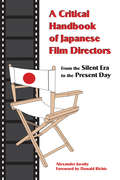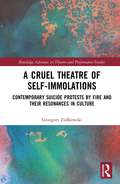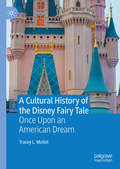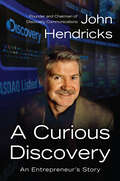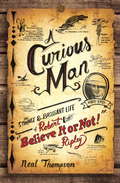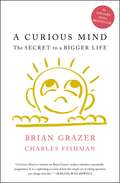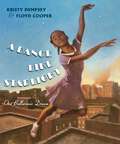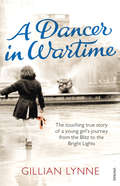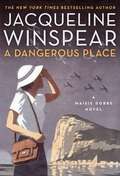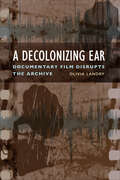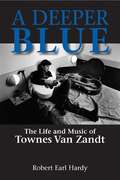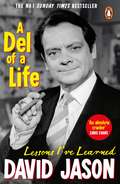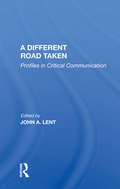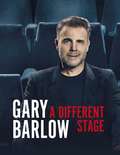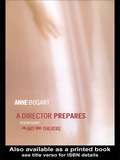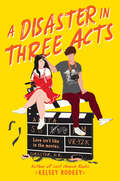- Table View
- List View
A Critical Guide to Horror Film Series (Routledge Library Editions: Cinema)
by Ken HankeIn this book the author takes a fresh look at horror film series as series and presents an understanding of how the genre thrived in this format for a large portion of its history. It sheds light on older films such as the Universal and the Hammer series films on Dracula, Frankenstein and the Mummy as well as putting more recent series into perspective, such as The Nightmare on Elm Street films. A well rounded review of these films and investigation into their success as a format, this useful volume, originally published in 1991, offers an attempt to understand the marriage of horror and the series film, with its pluses as well as minuses.
A Critical Handbook of Japanese Film Directors
by Donald Richie Alexander JacobyThis important work fills the need for a reasonably priced yet comprehensive volume on major directors in the history of Japanese film. With clear insight and without academic jargon, Jacoby examines the works of over 150 filmmakers to uncover what makes their films worth watching.Included are artistic profiles of everyone from Yutaka Abe to Isao Yukisada, including masters like Kinji Fukasaku, Juzo Itami, Akira Kurosawa, Takashi Miike, Kenji Mizoguchi, Yasujiro Ozu, and Yoji Yamada. Each entry includes a critical summary and filmography, making this book an essential reference and guide.UK-based Alexander Jacoby is a writer and researcher on Japanese film.
A Crooked Kind of Perfect
by Linda UrbanTen-year-old Zoe Elias has perfect piano dreams. She can practically feel the keys under her flying fingers; she can hear the audience's applause. All she needs is a baby grand so she can start her lessons, and then she'll be well on her way to Carnegie Hall. But when Dad ventures to the music store and ends up with a wheezy organ instead of a piano, Zoe's dreams hit a sour note. Learning the organ versions of old TV theme songs just isn't the same as mastering Beethoven on the piano. And the organ isn't the only part of Zoe's life that's off-kilter, what with Mom constantly at work, Dad afraid to leave the house, and that odd boy, Wheeler Diggs, following her home from school every day. Yet when Zoe enters the annual Perform-O-Rama organ competition, she finds that life is full of surprises--and that perfection may be even better when it's just a little off center.
A Cruel Theatre of Self-Immolations: Contemporary Suicide Protests by Fire and Their Resonances in Culture (Routledge Advances in Theatre & Performance Studies)
by Grzegorz ZiółkowskiA Cruel Theatre of Self-Immolations investigates contemporary protest self-burnings and their echoes across culture. The book provides a conceptual frame for the phenomenon and an annotated, comprehensive timeline of suicide protests by fire, supplemented with notes on artworks inspired by or devoted to individual cases. The core of the publication consists of six case studies of these ultimate acts, augmented with analyses and interpretations hailing from the visual arts, film, theatre, architecture, and literature. By examining responses to these events within an interdisciplinary frame, Ziółkowski highlights the phenomenon’s global reach and creates a broad, yet in-depth, exploration of the problems that most often prompt these self-burnings, such as religious discrimination and harassment, war and its horrors, the brutality and indoctrination of authoritarian regimes and the apathy they produce, as well as the exploitation of the so-called "subalterns" and their exclusion from mainstream economic systems. Of interest to scholars from an array of fields, from theatre and performance, to visual art, to religion and politics, A Cruel Theatre of Self-Immolations offers a unique look at voluntary, demonstrative, and radical performances of shock and subversion.
A Cuban Girl's Guide to Tea and Tomorrow: Soon to be a movie starring Kit Connor (Cuban Girl's Guide Ser.)
by Laura Taylor NameyLove isn't always part of the plan . . . A charming, heartwarming story following a Miami girl who unexpectedly finds love – and herself – in a small English town. Soon to be a movie starring Heartstopper's Kit Connor and Pretty Little Liars' Maia Reficco! For Lila Reyes, a summer in England hadn't been on the cards. Certainly not one stuck in the small town of Winchester with a lack of sun and zero Miami flavour. But when Lila meets Orion Maxwell in the local tea shop, her nightmare trip starts to look up. With a bright new future suddenly on the horizon, will Lila leave behind everything she's ever planned and follow her heart? A New York Times bestseller and Reese Witherspoon x Hello Sunshine Book Club YA Pick.PRAISE FOR A CUBAN GIRL'S GUIDE TO TEA AND TOMORROW: 'An absolute delight' Rachael Lippincott, author of Five Feet Apart 'An utterly charming read that feels like a treasured recipe that will heal and feed a broken heart.' Nina Moreno, author of Don&’t Date Rosa Santos 'I could live inside Laura Taylor Namey&’s lush, vibrant words forever.' Rachel Lynn Solomon, author of Today Tonight Tomorrow 'This book. THIS BOOK. Laura Taylor Namey has written the coziest love story I&’ve ever had the pleasure to read.' Erin Hahn, author of You&’d Be Mine and More Than Maybe
A Cultural History of the Disney Fairy Tale: Once Upon an American Dream
by Tracey L. MolletThis book charts the complex history of the relationship between the Disney fairy tale and the American Dream, demonstrating the ways in which the Disney fairy tale has been reconstructed and renegotiated alongside, and in response to important changes within American society. In all of its fairy tales of the twentieth and twenty-first centuries, the Walt Disney studios works to sell its audiences the national myth of the United States at any one historical moment. With analyses of films and television programmes such as The Little Mermaid (1989), Frozen (2013), Beauty and the Beast (2017) and Once Upon a Time (2011-2018), Mollet argues that by giving its fairy tale protagonists characteristics associated with ‘good’ Americans, and even by situating their fairy tales within America itself, Disney constructs a vision of America as a utopian space.
A Curious Discovery: An Entrepreneur's Story
by John S. HendricksIn A Curious Discovery, media titan John Hendricks tells the remarkable story of building one of the most successful media empires in the world, Discovery Communications.John Hendricks, a well-respected corporate leader and brand builder, reveals that his professional achievements would not have been possible without one crucial quality that has informed his life since childhood: curiosity. This entrepreneur’s story takes you behind the scenes of some of the network’s most popular shows and greatest successes, and imparts crucial lessons from the network’s setbacks.With insights, anecdotes, photographs, and real-world wisdom, A Curious Discovery is more than a powerful autobiography and corporate history: It also a valuable primer for business innovators and entrepreneurs.
A Curious Man: The Strange and Brilliant Life of Robert "Believe It or Not!" Ripley
by Neal ThompsonA Curious Man is the marvelously compelling biography of Robert "Believe It or Not" Ripley, the enigmatic cartoonist turned globetrotting millionaire who won international fame by celebrating the world's strangest oddities, and whose outrageous showmanship taught us to believe in the unbelievable.As portrayed by acclaimed biographer Neal Thompson, Ripley's life is the stuff of a classic American fairy tale. Buck-toothed and cursed by shyness, Ripley turned his sense of being an outsider into an appreciation for the strangeness of the world. After selling his first cartoon to Time magazine at age eighteen, more cartooning triumphs followed, but it was his "Believe It or Not" conceit and the wildly popular radio shows it birthed that would make him one of the most successful entertainment figures of his time and spur him to search the globe's farthest corners for bizarre facts, exotic human curiosities, and shocking phenomena.Ripley delighted in making outrageous declarations that somehow always turned out to be true--such as that Charles Lindbergh was only the sixty-seventh man to fly across the Atlantic or that "The Star Spangled Banner" was not the national anthem. Assisted by an exotic harem of female admirers and by ex-banker Norbert Pearlroth, a devoted researcher who spoke eleven languages, Ripley simultaneously embodied the spirit of Peter Pan, the fearlessness of Marco Polo and the marketing savvy of P. T. Barnum.In a very real sense, Ripley sought to remake the world's aesthetic. He demanded respect for those who were labeled "eccentrics" or "freaks"--whether it be E. L. Blystone, who wrote 1,615 alphabet letters on a grain of rice, or the man who could swallow his own nose.By the 1930s Ripley possessed a vast fortune, a private yacht, and a twenty-eight room mansion stocked with such "oddities" as shrunken heads and medieval torture devices, and his pioneering firsts in print, radio, and television were tapping into something deep in the American consciousness--a taste for the titillating and exotic, and a fascination with the fastest, biggest, dumbest and most weird. Today, that legacy continues and can be seen in reality TV, YouTube, America's Funniest Home Videos, Jackass, MythBusters and a host of other pop-culture phenomena. In the end Robert L. Ripley changed everything. The supreme irony of his life, which was dedicated to exalting the strange and unusual, is that he may have been the most amazing oddity of all.From the Hardcover edition.
A Curious Mind: The Secret to a Bigger Life
by Charles Fishman Brian Grazer#1 New York Times bestselling author and Oscar–winning producer Brian Grazer has written a brilliantly entertaining and eye-opening exploration of curiosity and the life-changing effects it can have on every person’s life.From Academy Award–winning producer Brian Grazer, New York Times bestseller A Curious Mind offers a brilliant peek into the “curiosity conversations” that inspired him to create some of the world’s most iconic movies and television shows. He shows how curiosity has been the “secret” that fueled his rise as one of Hollywood’s leading producers and creative visionaries, and how all of us can channel its power to lead bigger and more rewarding lives. Grazer has spent most of his life exploring curiosity through what he terms “curiosity conversations” with some of the most interesting people in the world, including spies, royals, scientists, politicians, moguls, Nobel laureates, artists…anyone whose story might broaden his worldview. These discussions sparked the creative inspiration behind many of his movies and TV shows, including Splash, 24, A Beautiful Mind, Apollo 13, Arrested Development, 8 Mile, J. Edgar, Empire, and many others. A Curious Mind is not only a fascinating page-turner—it also offers a blueprint for how we can awaken our own curiosity and use it as a superpower in our lives. Whether you’re looking to strengthen your management style at work, uncover a new source of creativity, or become a better romantic partner, this book—and its lessons on the power of curiosity—can change your life.
A Dance
by Alexander BarabanovAlexander Barabanov, a key figure in the Russian dance world, has sifted through many thousands of photographs of dance to accumulate an extraordinary collection of pictures, ranging from historical ballet photographs to shocking avant-garde imagery.This work has been collected and edited to form an astonishing sequence. Rather than being assembled as an anthology, the sequence has in fact been 'choreographed' so the book is constructed to form a dance in ten movements. It begins with creation myths, follows erotic engagements and leads to a series of mass movements in the modern age. It includes such gems as the young Nureyev's first performance with the Kirov and Baryshinikov's debut as well as images with brutal reference to Abu Ghraib or the march of fascism.
A Dance Like Starlight: One Ballerina's Dream
by Kristy DempseyA story of little ballerinas with big dreams.Little ballerinas have big dreams. Dreams of pirouettes and grande jetes, dreams of attending the best ballet schools and of dancing starring roles on stage. But in Harlem in the 1950s, dreams don’t always come true—they take a lot of work and a lot of hope. And sometimes hope is hard to come by. But the first African-American prima ballerina, Janet Collins, did make her dreams come true. And those dreams inspired ballerinas everywhere, showing them that the color of their skin couldn’t stop them from becoming a star. In a lyrical tale as beautiful as a dance en pointe, Kristy Dempsey and Floyd Cooper tell the story of one little ballerina who was inspired by Janet Collins to make her own dreams come true.
A Dance Of Sisters
by Tracey PorterI want to stretch to the moon, Delia thought. Far, far away. Twelve-year-old Delia Ferri doesn't remember her mother or her family the way it used to be. All she knows is that her sister, Pearl, and her father are fighting more and more. Pearl is withdrawn and angry and obsessed with witchcraft. Delia vows not to give her father anything else to worry about. The only time Delia feels important and alive is when she is dancing for Madame Elanova, a world-famous ballet instructor who calls Delia "destined." Delia relishes the hard work required to be a ballet dancer, but she doesn't see the toll it is taking on her life. As competition for Madame's approval takes over, Delia's weight drastically drops, her schoolwork suffers, and she pulls away from her friends and family. Only then does she begin to understand how fiercely her sister had to fight to find her own truth. A Dance of Sisters is an intimate portrait of the rigorous world of ballet, and a story of two girls searching for connection. Tracey Porter's beautiful novel explores the many dances of life, and the bond between sisters that sometimes only experience can reveal.
A Dancer in Wartime: The touching true story of a young girl's journey from the Blitz to the Bright Lights
by Gillian LynneLondon during the Blitz was a time of hardship, heroism and hope.For Gillian Lynne – a budding ballerina – it was also a time of great change as she was evacuated from war-torn London to a crumbling mansion, where dance classes took place in the faded ballroom.Life was hard, but her talent and dedication shone through and an astonishing journey ensued, which saw Gillian dancing a triumphant debut in Swan Lake, performing in the West End with doodlebugs falling and touring a devastated Europe entertaining the troops.A Dancer in Wartime paints a vivid and moving picture of what life was really like during the hard years of the Blitz and brings to life a lost world.
A Dangerous Place (Maisie Dobbs #11)
by Jacqueline WinspearFour years after she set sail from England, leaving everything she most loved behind, Maisie Dobbs at last returns, only to find herself in a dangerous place...<P><P> In Jacqueline Winspear‘s powerful story of political intrigue and personal tragedy, a brutal murder in the British garrison town of Gibraltar leads Maisie into a web of lies, deceit, and peril.<P> Spring 1937. In the four years since she left England, Maisie Dobbs has experienced love, contentment, stability—and the deepest tragedy a woman can endure. Now, all she wants is the peace she believes she might find by returning to India. But her sojourn in the hills of Darjeeling is cut short when her stepmother summons her home to England; her aging father Frankie Dobbs is not getting any younger.<P> But on a ship bound for England, Maisie realizes she isn’t ready to return. Against the wishes of the captain who warns her, “You will be alone in a most dangerous place,” she disembarks in Gibraltar. Though she is on her own, Maisie is far from alone: the British garrison town is teeming with refugees fleeing a brutal civil war across the border in Spain.<P> Yet the danger is very real. Days after Maisie’s arrival, a photographer and member of Gibraltar’s Sephardic Jewish community, Sebastian Babayoff, is murdered, and Maisie becomes entangled in the case, drawing the attention of the British Secret Service. Under the suspicious eye of a British agent, Maisie is pulled deeper into political intrigue on “the Rock”—arguably Britain’s most important strategic territory—and renews an uneasy acquaintance in the process. At a crossroads between her past and her future, Maisie must choose a direction, knowing that England is, for her, an equally dangerous place, but in quite a different way.
A Decolonizing Ear: Documentary Film Disrupts the Archive
by Olivia LandryThe recording of Indigenous voices is one of the most well-known methods of colonial ethnography. In A Decolonizing Ear, Olivia Landry offers a sceptical account of listening as a highly mediated and extractive act, influenced by technology and ideology. Returning to early ethnographic practices of voice recording and archiving at the turn of the twentieth century, with a particular focus on the German paradigm, she reveals the entanglement of listening in the logic of Euro-American empire and the ways in which contemporary films can destabilize the history of colonial sound reproduction. Landry provides close readings of several disparate documentary films from the late 1990s and the early 2000s. The book pays attention to technology and knowledge production to examine how these films employ recordings plucked from different colonial sound archives and disrupt their purposes. Drawing on film and documentary studies, sound studies, German studies, archival studies, postcolonial studies, and media history, A Decolonizing Ear develops a method of decolonizing listening from the insights provided by the films themselves.
A Deed of Death: The Story Behind the Unsolved Murder of Hollywood Director William Desmond Taylor
by Robert GirouxWell-born but disinherited Anglo-Irish actor and one-time Yukon prospector, William Desmond Taylor was a prominent Paramount movie director at the time of his unsolved murder in 1922. Suspects included his secretary Edward Sands, a thief and forger; Henry Peavey, his homosexual black cook; and two flamboyant screen stars: drug-addicted Mabel Normand, whom he loved; and 20-year-old Mary Miles Minter, who yearned to be his mistress. In a meticulous probe that reads like a detective thriller, editor-publisher Giroux ( The Book Known as Q ) makes a strong case that the murderer was a contract killer. He shows that Normand had incurred the wrath of dope peddlers, as did Taylor when he attempted to help her break her addiction. Brimming with details of Hollywood's silent era and its rampant post-WW I drug culture, this procedural offers glimpses of Mary Pickford, Charlie Chaplin, Sam Goldwyn, Mack Sennett, Fatty Arbuckle. Illustrations. Copyright 1990 Reed Business Information, Inc.
A Deeper Blue: The Life and Music of Townes Van Zandt
by Robert Earl HardyBiography of Texas Singer/Songwriter Townes Van Zandt
A Del of a Life: The hilarious #1 bestseller from the national treasure
by David JasonTHE #1 SUNDAY TIMES BESTSELLER: a hilarious and heartfelt new autobiography from the national treasure Sir David Jason'There are British telly icons and then there is Sir David Jason. This book is such gold . . . an absolute delight' ZOE BALL___________________________'During my life and career I have been given all sorts of advice and learned huge amounts from some great and enormously talented people. I've been blessed to play characters such as Derek Trotter, Granville, Pop Larkin and Frost, who have changed my life in all sorts of ways, and taught me lessons that go far beyond the television set. And I've worked a few things out for myself as well, about friendship, ambition, rejection, success, failure, adversity and fortune.With any luck, some of these thoughts and observations will chime with episodes and challenges you have faced, or are facing, in your own life. And if they don't. . . well, hopefully, at the very least you'll get to have a good old laugh at my expense.So lean back, pour yourself a glass, and try not to fall through the bar flap . . .'___________________________'An absolute delight . . . a romp with so much detail. Offers wisdom in difficult times . . . like being invited into his living room' BBC BREAKFAST'It's beautifully written . . . so conversational and chatty . . . it's so lovely and warm' CHRIS MOYLES
A Dictionary of Theatre Anthropology: The Secret Art of the Performer
by Eugenio Barba Nicola SavareseFirst Published in 2005. Routledge is an imprint of Taylor & Francis, an informa company.
A Different Road Taken: Profiles In Critical Communication
by John A LentDallas Smythe, George Gerbner, Herbert Schiller, James Halloran, Kaarle Nordenstreng- these five seminal figures form the backbone of current scholarship in critical communication. From policy research to television demographics and from economic globalization to cultural imperialism, their insights and discoveries have given both scholars and the
A Different Stage: The remarkable and intimate life story of Gary Barlow told through music
by Gary BarlowTHE SUNDAY TIMES BESTSELLERJoin national treasure Gary Barlow as he opens the curtains on his remarkable life in this stunning autobiography, from his fascinating early life to his star-studded music career'Warm, wise . . . A never-before-seen insight into one of Britain's greatest songwriters' Woman's Own'I just wanted to share my personal journey through the last five decades - the highs and lows, the ups and downs. So in A Different Stage, this is me opening the curtains and sharing moments nobody has heard or seen before . . .'__________In this warm, intimate and humorous book, rich with nostalgia and unexpected intimate detail, Gary Barlow unpacks the people, music, places, things and cultural phenomena that have made him the man that he is.From the working men's club where it all began through to the sold out stadium tours, this is the story of Gary's life told through music.Filled with a mixture of brand new photography from Gary's current one-man show and incredibly personal unseen photos and notebooks, A Different Stage is a beautiful book about the man we've spent our lives listening to.__________'Refreshingly honest . . . Think you know everything there is to know about the Take That megastar? Think again' Woman & Home
A Director Prepares: Seven Essays on Art and Theatre
by Anne BogartA Director Prepares is a thought-provoking examination of the challenges of making theatre. In it, Anne Bogart speaks candidly and with wisdom of the courage required to create 'art with great presence'. Each chapter tackles one of the seven major areas Bogart has identified as both potential partner and potential obstacle to art-making. They are Violence; Memory; Terror; Eroticism; Stereotype; Embarrassment; and Resistance. Each one can be used to generate extraordinary creative energy, if we know how to use it. A Director Prepares offers every practitioner an extraordinary insight into the creative process. It is a handbook, Bible and manifesto, all in one. No other book on the art of theatre comes even close to offering this much understanding, experience and inspiration.
A Director's Method for Film and Television (Routledge Library Editions: Broadcasting #1)
by Ron RichardsA Director’s Method for Film and Television (1992) presents the ‘cinematic language’ approach to directing for film and television directors. It shows how the viewer perceives the nuances of the various pictures used to tell the story, and how movement within the frame creates drama and development. It outlines the techniques necessary to maximize each and every shot and create professional results.
A Disaster in Three Acts
by Kelsey RodkeyFans of Elise Bryant and Rachel Lynn Solomon will swoon for Last Chance Books author Kelsey Rodkey’s next romance, packed with snark, banter, and inconvenient crushes.Saine Sinclair knows a little something about what makes a story worth telling.Your childhood best friend refuses to kiss you during a pre-adolescent game of spin the bottle? Terrible, zero stars, would not replay that scene again. The same ex-friend becomes your new best friend’s ex? Strangely compelling, unexpected twist, worth a hate-watch. That same guy—why is he always around?—turns out to be your last shot at getting into the documentary filmmaking program of your dreams? Saine hates to admit it, but she’d watch that movie.There’s something about Holden that makes her feel like she’s the one in front of the camera—like he can see every uncomfortable truth she’s buried below the surface. Saine knows how her story’s supposed to go. So why does every moment with Holden seem intent on changing the ending?
A Dog Named Toe Shoe (Bad News Ballet #10)
by Jahnna N. Malcolm[from the back cover] "Doggone! Okay, so the stray mutt that the gang finds near their dance school isn't the cutest dog they've ever seen... but the girls fall in love with him anyway. And they decide to make Toe Shoe their mascot. Only problem is, none of the gang's parents will let them have a dog. And then their enemy, Courtney, gets poor Toe Shoe thrown in the pound. Rocky, Zan, McGee, Mary Bubnik, and Gwen may be known for messing things up--but they're going to get their dog back if it's the last thing they do right!" There are more funny situations in store for these ballet school friends who like each other more than they like ballet. The Bookshare collection has the whole series. Catch up on any of the books in this series you've missed. Check out #1 The Terrible Try outs, #2 Battle of the Bunheads, #3 Stupid Cupids, #4 Who Framed Mary Bubnik, #5 Blubberina, #6 Save D.A.D., #7 The King and Us, #8 Camp Clodhopper, #9 Boo Who?, and #10 A Dog Named Toe Shoe.

